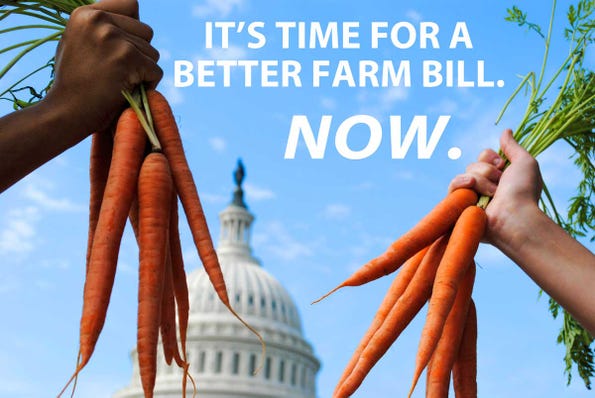Farm Bill allocates millions for junk food, cuts food stampsFarm Bill allocates millions for junk food, cuts food stamps

 Though I haven't taken the time to dive in to the Farm Bill's 673 pages, I'd assumed (as I'm sure have other consumers) that the legislation was in place to protect small farmers, secure access to healthy food and support low-income families. Wasn't that its original intent when the bill was drafted during the Great Depression? Somehow (read, lobbyists and agribusinesses) we've strayed far from those goals and the latest version sets us further adrift.
Though I haven't taken the time to dive in to the Farm Bill's 673 pages, I'd assumed (as I'm sure have other consumers) that the legislation was in place to protect small farmers, secure access to healthy food and support low-income families. Wasn't that its original intent when the bill was drafted during the Great Depression? Somehow (read, lobbyists and agribusinesses) we've strayed far from those goals and the latest version sets us further adrift.
The bill continues to allocate millions of taxpayer dollars to farm subsidies–most of which are used to fuel the production of junk food ingredients. Experts agree there's little need for these subsidies since 80 percent of funds flow to households that are much wealthier than the average American family, and farm-to-debt asset ratios are at record lows.
While corporate agricultural subsidies actually increased, the new bill strips the Supplemental Nutritional Assistance Program i.e. food stamps, essentially robbing from the poor to give to the rich. Rep.Mike Kelly, a Pennsylvania Republican, said on CBS's "Face the Nation" that "we're wasting billions of dollars on a program that doesn't seem to be lifting people out of poverty." I fail to see how cutting assistance presents a better solution.
Still, if we gave the subsidies to each taxpayer to buy the crop they were allocated for, it would still not add up. Apple subsidies would enable each person to buy only half an apple each year according to the report, Apples to Twinkies 2013, released this week by the consumer advocacy group CoPIRG. The annual amount we spend to produce high fructose corn syrup would allow consumers to buy up to 20 Twinkies each.
At a time when America faces astronomical rates of obesity and diabetes, this is absolutely ludicrous. Our history of supporting the wealthiest farms producing the unhealthiest crops extends back several years.
Among the report's key findings:
Of the total $292.5 billion allotted in agriculture subsidies, 3.8 percent of farmers collected $178.5 billion, while 62 percent of farms did not receive any federal funds.
Taxpayers spent $84.4 billion on corn production, $8.1 billion of which funded production of corn starch and sweeteners. Of the total domestic corn produced, 9.6 percent ended up in junk food and beverages as sweeteners or thickeners. Soy subsidies rank fifth on the list of subsidized crops, costing taxpayers $27.8 billion. Since 1995, soy oils have consumed approximately $11.1 billion in taxpayer subsidies.
With the money used to subsidize corn and soy junk food ingredients, the government could buy almost 52 billion Twinkies—enough to circle the Earth 132 times when placed end to end or meet the caloric needs of the entire U.S. population for 12 days.
Reforms are clearly necessary, but we'll need to wait another five years before that can happen. I suspect that like me, most consumers haven't taken time to follow Farm Bill developments. It's confusing and political. If there's any benefit to this latest iteration its that it makes the issues black and white: The new Bill cuts nutrition programs for the poor and increases government handouts to thousands of millionaire corn, wheat and soybean farmers. Spread the word.
About the Author
You May Also Like



